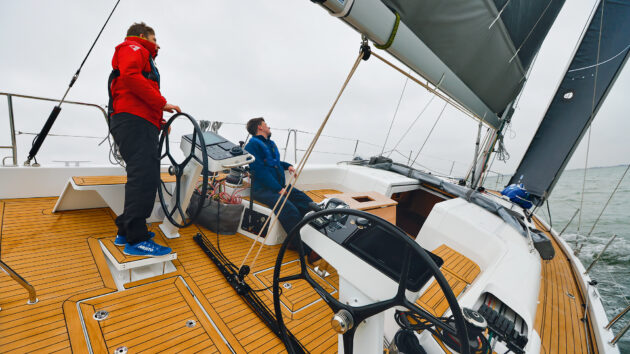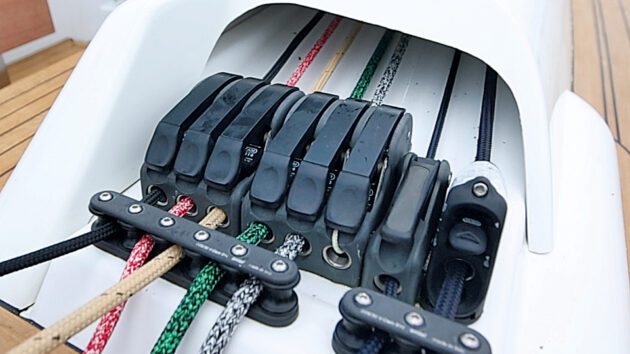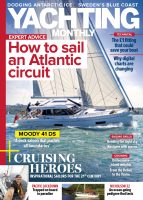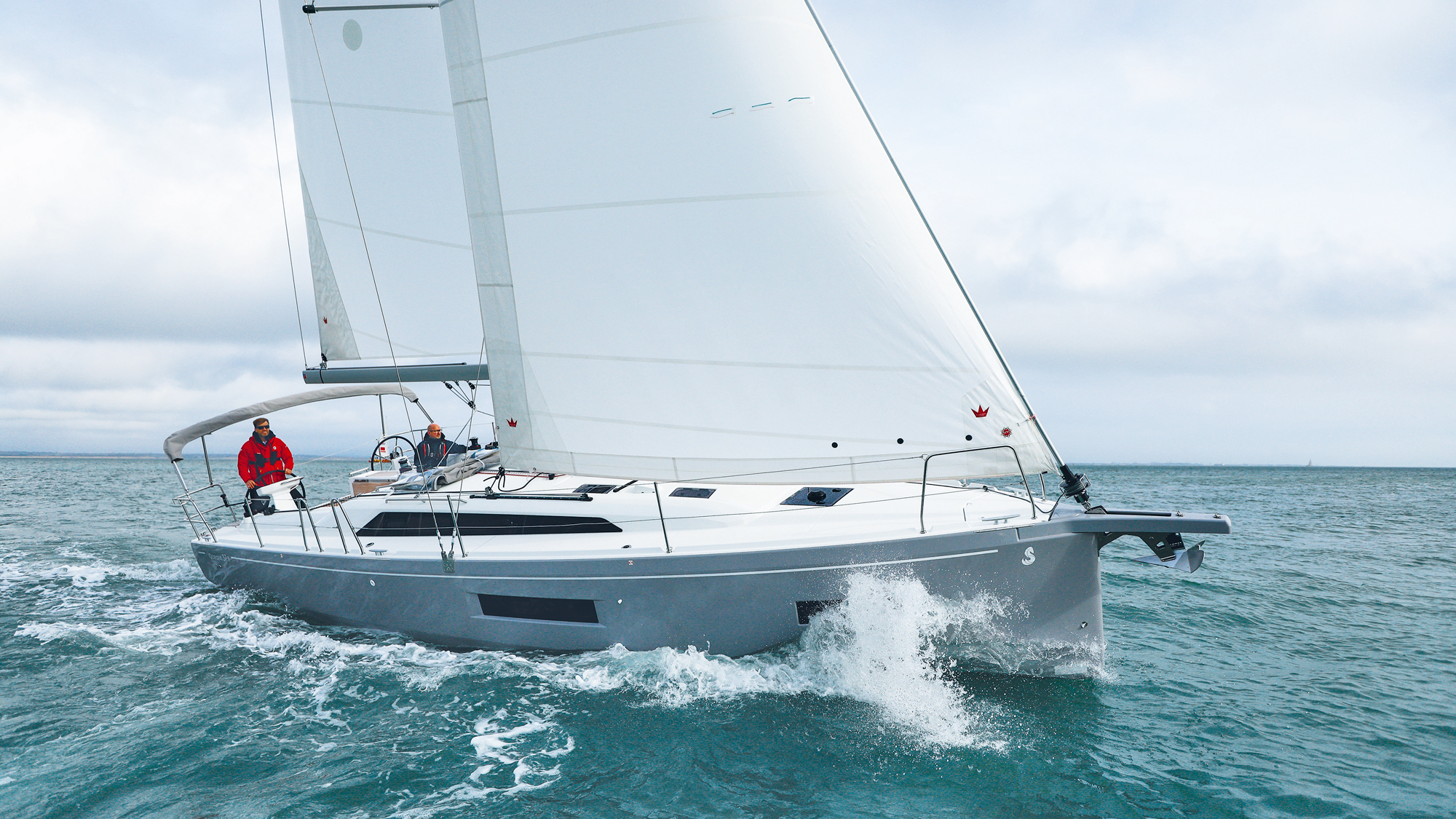With variants suited to racing as well as cruising, the Beneteau First 44 is a superbly competent boat of two halves, writes Theo Stocker
Beneteau First 44 review: Docile herbivore of a boat, or a meat-hungry carnivore?
Disney princesses may not be the first thing that come to mind when sailing in mid December, but as we stepped aboard, the boat’s stereo was belting out Elsa from Frozen singing ‘Let it go, let it go, the cold never bothered me anyway’ in an oddly appropriate moment of radio serendipity.
A fine drizzle, threatening to morph into snow, fell from a leaden sky and we wondered about the wisdom of our decision to go ahead with the test of Beneteau’s new Beneteau First 44. The forecast of wind, however, and the absence of both 50-knot storms and rain seemed like as good a prospect as any for this time of year.
I had admired the lines of the Beneteau First 44 earlier in the season when testing the Beneteau Oceanis 37.1, and had also seen the boat at her first public appearance, albeit out of the water, at Boot Düsseldorf, 18 months earlier. Any sailor, whether cruiser or racer, will be well aware of just how popular the ‘First’ range as been for Beneteau. The promise of modern design, sprightly performance and a sensible price tag have had an enduring and widespread appeal since Beneteau’s First 30 appeared in 1977.
The range languished for a few years until two things happened. Beneteau brought out the Biscontini-designed First 53, a big, powerful boat a world away from the small cruiser racers First used to be known for. It then bought Slovenian company Seascape, builder of small, Samuel Manuard-designed sportsboats from 14 to 27 feet, and rebranded these as Beneteau Firsts.
Since then, the French yard has been filling in the gaps. The Beneteau First 44 and the Beneteau First 36 launched at the same time in early 2023 as performance cruisers with proper racing potential. On show at Düsseldorf 2025 was the brand new First 30, completing the range back where it started all those years ago.

A superbly competent boat of two halves. Photo: Paul Wyeth
Chameleon colours
The interesting thing about the Beneteau First 44 is that it is something of a chameleon. At first glance, it has the high topsides, wide stern and twin rudders that define the current crop of high volume cruisers.
But this belies the subtleties added by Biscontini that may be more easily missed: an absence of hard hull chines often used to supercharge internal volume; a narrow waterline and more rounded canoe body to reduce wetted surface; a fine bow and pinched-in stern at the waterline all make for slippery light-air sailing as well as top end speed of a performance machine. But the real trick is just how differently this boat can be configured for either racing or cruising.
Pick the spartan fit-out of the performance version, do away with anchor windlass, covered decks and AGM batteries, add on a 1.6m taller carbon rig and a deep 2.6m keel and save half a tonne’s displacement. Or you can add 15m2 (163 sq ft) of canvas for a (slightly) more sedate, luxurious cruising version.
Article continues below…
First look: Beneteau First 36
Although not officially launched at the Cannes Yachting Festival, this was the first time we had been able to step…
Beneteau Oceanis 37.1 review: Easy, enjoyable, and forgiving
The Beneteau Oceanis 37.1 is the latest model in the Beneteau Oceanis range – one of the best-known and recognisable…
While the performance version has three pairs of winches arranged around the cockpit and a layout configured for crewed racing, the cruising version is optimised for shorthanded sailing, with two pairs of winches either side (powered if you want them), just forward of the helms to handle the lines that are all led aft. You can add in water ballast tanks if you want a bit more oomph for shorthanded racing (equivalent to 350kg of rail meat hiking out, to be precise), but you may prefer the extra locker space, cockpit cushions and deep-pile carpet – the creature comforts that no self-respecting connoisseur would want to do without.
This was how our test boat was fitted out, and while it may seem like a binary choice, there is a long list of options from which to pick and choose. We had the benefit of a downwind pack to handle the truly massive 207m2 asymmetric spinnaker, plus the North 3Di sails our boat was fitted with, making her a comfortable cruiser, but with teeth.

Useful bracing positions make the large cockpit feel more secure. Photo: Paul Wyeth
I was keen to see whether this would prove to be a docile herbivore of a boat, or a meat-hungry carnivore. Both versions have the option of a retractable bow thruster, though our boat wasn’t fitted with it, meaning that the first excitement came as we manoeuvred out of a tight berth in a decent breeze.
We emerged, blinking and a little disorientated, into Southampton Water. The breeze funnelling down the Hamble died away, leaving us drifting over grey ripples under grey clouds. Nevertheless we set the panther-black fibre sails and hoped for the best. Thankfully, the breeze filled in. A northeasterly is always a flukey wind in the Solent, and the wind swung through 30 degrees and fluctuated between 8 and 15 knots, but it continued to build and then steadied as the day progressed.

Lines are led aft to clutches through covered ducts. Photo: Paul Wyeth
Finding our groove
This was the second time the boat had been out with these sails, and it’s always going to take a bit of time to get things settled in. A two-to-one main halyard helped get the big-roached sail up the mast, though a cruising sailor might opt for a powered winch.
With sails that are this resistant to stretch, getting halyard tensions just right is critical, and it was a bit of a shame that the halyards themselves weren’t Dyneema, meaning that luffs began to crinkle gradually as the ropes stretched.

Electric winching makes light work of the bathing platform, revealing the tender garage. Photo: Paul Wyeth
Backstay tension was adjusted to help forestay tension and sail shape. We might not have been as dialled in as a race crew would want – I’m not sure we had quite enough tension on halyards and backstay, or jib cars far back enough – but the setup was good enough for government work.
Getting on the wind and in the groove became easier and easier as we got to know the boat, and before long the pleasure of helming a proper sailing machine hard on the wind filled in with the breeze. Twin rudders often make the helm feel rather numb but here the designers seem to have got the balance of the rudders just right.

Large leaves fold up to make a generous cockpit table. Photo: Paul Wyeth
The gradual loading up of weather helm and the effect of adjusting sail trim to rebalance the boat were all delightfully apparent through the lightweight wheels – a properly balanced boat is always faster than one made to feel so with an overly neutral rudder. A little more cable tension would have improved the feel even further.
The cruising deck layout worked well, though if you are likely to race seriously, the winches ahead of the wheels could get a little congested, as they did when we were handling main, genoa and kite simultaneously. The deck gear was well-specced, as long as you use the larger Harken 56ST winch for the German mainsheet.

Dyneema halyards would help eliminate luff crinkles otherwise destined to creep back in under load. Photo: Paul Wyeth
The lines, emerging from the ducting that leads them aft, fall neatly from the bank of clutches into rope bags aft of the seats, though with massive two-to-one halyards these could usefully be a little larger. The optional mainsheet traveller was a good addition, giving a lot more control over boom position and sail shape than the standard fixed padeye.
The fractional 9/10ths two-spreader aluminium rig is controlled with a dual-cylinder hydraulic backstay from Harken, with a pump forward of the port helm giving good control over the rig.

The galley is huge and well lit, with plenty of space to prepare meals. Photo: Paul Wyeth
Smart details
The ergonomics of the helm positions work well, with a good view of the plotters on either pedestal and buttons to control ballast tanks (if fitted), nav lights and the electrically lowering bathing platform. Seats outboard of the wheel and lifting foot chocks ensure comfortable helming sitting or standing.
I particularly like the recess below the overhanging aft end of the cockpit coaming, which created extra space to stand when helming from leeward with a clear view of the jib. There’s still space to walk around the aft end of the coaming with a small step up to the sidedecks, avoiding a clamber over the seats. It’s a wide cockpit but the solid midships table offered good bracing and made it feel safe and secure when heeled.

The table lowers electrically to create a large double berth. Photo: Paul Wyeth
Moving around on deck was easy with or without the sprayhood up thanks to wide decks and a grabrail where it was needed. The synthetic teak offered good grip, as did the moulded grip on the coachroof, matching what would be on the side decks if you didn’t opt for deck coverings to keep weight down.
Towable jib cars are set into the coachroof, and steps at the mast made it easier to reach the head of the sail, while the boom was supported by a gas-strut vang, with a four-to-one kicker purchase lead through low friction rings taken back to the main winches.

There is plenty of space and light, natural and artificial, in the forward cabin with a clean if functional finish. Photo: Paul Wyeth
At the bow, a deep fo’c’sle locker was large enough to swallow fenders and an offwind sail, with the windlass neatly tucked at the forward end over a chain locker sealed with a watertight hatch. Our boat was fitted with a stem-mounted forestay and a flatdeck furler with a tape-reel drum, while there’s a pre-moulded space for underdeck furling on the performance model. On the latter, you would also lose the bow roller built into the metre-long moulded bowsprit, which has two tack points for Code Zero or asymmetric sails.
Fresh thinking below
Going below, this boat feels refreshingly modern. Good use has been made of the space, and while the layout is not unconventional, choices such as the fore and aft dinette in place of a C-shaped saloon seating to port, and moving the galley sink from central worktop to aft of the oven felt noticeably different.

Aft cabins are comfortable for racing crew or friends and family on holiday. Photo: Paul Wyeth
The boat only comes in one layout for either version, and that’s three cabins with two heads (one main and one in the forward cabin), while the dinette table, capable of seating six, lowers down to make another double bed, so if you had a full race crew you could theoretically sleep nine on board.
I was pleased to see a chart table had been retained, facing aft on the starboard side, with enough space for a leisure folio paper chart, with a 12in plotter above it so that planning can be done in comfort in harbour as well as ‘proper’ navigation at sea.
With tanks kept out of the way in the forward and aft cabins, there was plenty of stowage under the saloon seats and systems behind the starboard seat back had been kept pretty well protected.

The main heads includes a separate shower compartment. Photo: Paul Wyeth
Nice touches included the hull linings, concealing LED strip lights and blinds around the hull windows and laminated hardwood edging around the chart table galley, though not around the saloon table and in one or two other places where it would help make things a little more robust. Seat bases were veneered and varnished rather than left as plain plywood, which all helps with the impression of quality.
Beneteau had achieved an attractive and practical fit-out, while keeping things pretty simple; lockers around the galley were adequate but not luxurious, the sink might have benefitted from having two bowls rather than one, and there were no overhead lockers or shelving.

A chart table with plotter allow for navigation
and planning below. Photo: Paul Wyeth
Extras such as air conditioning and forced air diesel heating would add to comfort levels, though the carpets that had been ordered with this boat would certainly add to the feeling of luxury.
This is a boat you could cruise with a few crew in comfort, though might prove a little basic for more serious longer-term adventures.
Simply attractive
The cabins were very spacious and comfortable. With large doubles and good upright lockers in both of the aft cabins, and a central island berth in the forward cabin, all berths were at least two metres long and 160cm wide. Stowage beneath the berths is taken up with tanks (200L fuel port side aft, an optional extra 200L of water under the starboard aft berth, and 350L water under the forward cabin berth as standard).

The 207m2 asymmetric is an awesome sail for powerful offwind cruising, if not leeward visibility. Photo: Paul Wyeth
As in the saloon, some of the boxing-in could have been better used for extra stowage, and there were no overhead lockers, but the overall impression was very pleasant. The master cabin forwards also enjoys its own heads compartment. The shower isn’t separate, but a folding screen stops the rest of the compartment getting soaked. The main heads does have a separate shower aft, and both have hooks so you can hang dripping waterproofs to dry after a hard sail.
There’s only one diesel engine option on this boat, and that’s a very respectable 57hp Yanmar with saildrive transmission to a three-bladed folding prop. Even with the main flogging as we motored into the wind, we managed a good 8.5-9.0 knots at 3,000rpm and a comfortable 8.0-8.5 at 2,600rpm.

A crewed boat will really show off the First 44’s performance talents. Photo: Paul Wyeth
My only criticism of the engine is that the water strainer can’t be visually inspected in situ, so the lid and basket have to be removed to see if there is anything in there when doing engine checks, though getting to it via the hatch in the port aft cabin is easy enough.
Beneteau First 44 specifications
LOA: 14.15m / 46ft 5in
Hull length: 13.17m / 43ft 2in
LWL: 12.82m / 42ft 1in
Beam: 4.25m 13ft 11in
Standard Draught: 2.15m / 7ft 1in
Performance Draught: 2.60m / 8ft 6in
Displacement: 10,660kg / 23,495 lb
Standard Ballast: 3,300kg / 7,275 lb
Performance Ballast: 3,000kg / 6,612 lb
Air draught: 19.70m / 64ft 8in (carbon 21.32m 69ft 11in)
Sail area: 103m² / 1,109 sq ft
Engine: 57hp Yanmar
Transmission: Saildrive
Water: 370L / 98 Gal (option plus 200L / 53 Gal)
Fuel: 200L / 53 Gal
RCD Category: A12
Price as tested: £558,505 inc VAT
Designer: Biscontini / Argento
Builder: Beneteau Group
Enjoyed reading this?
A subscription to Yachting Monthly magazine costs around 40% less than the cover price, so you can save money compared to buying single issues.
Print and digital editions are available through Magazines Direct – where you can also find the latest deals.
YM is packed with information to help you get the most from your time on the water.
-
-
- Take your seamanship to the next level with tips, advice and skills from our experts
- Impartial in-depth reviews of the latest yachts and equipment
- Cruising guides to help you reach those dream destinations
-
Follow us on Facebook, Twitter and Instagram.
Verdict
This is a proper sailing boat with the potential for fast, exciting racing. It is also a refined cruising boat with the manners for quick but comfortable passage making. The fact that the two options are so substantially different presents the reviewer with something of a dilemma. I feel in some ways that this is a boat that couldn’t quite decide what it wanted to be when it grew up. For potential buyers, I would encourage you to honestly evaluate the kind of sailing you want to do before you go to town on the options list. Quality overall is good and the finish is well executed, though fit-out is noticeably more basic than you might find on other luxury performance cruisers, in part to save weight, though it helps keep the boat keenly priced too. I’d have liked a little more solid wood edging, and slightly better use of the potential stowage spaces.





